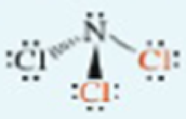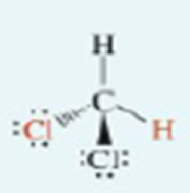
EBK LABORATORY MANUAL FOR GENERAL, ORGA
3rd Edition
ISBN: 9780321918352
Author: Timberlake
Publisher: YUZU
expand_more
expand_more
format_list_bulleted
Textbook Question
Chapter 3, Problem 3.46PP
For the molecules shown, indicate whether the orange-colored atoms are in-front-of, behind, or in the plane of this book.


Expert Solution & Answer
Want to see the full answer?
Check out a sample textbook solution
Students have asked these similar questions
All of these compounds would be produced (I think). In my book, I don't see any rules about yield in this case, like explaining that one product would be present in less yield for this reason or that reason. Please explain why some of these produce less yield than others.
5. Fill in the missing molecules in the following reaction pathway.
TMSO
Heat
+
CI
then HF
O₂N
(1.0 equiv)
AICI 3
OMe
e.
O₂N
NO2
1. excess H2, Pd/C
2. excess NaNO2, HCI
3. excess CuCN
Chapter 3 Solutions
EBK LABORATORY MANUAL FOR GENERAL, ORGA
Ch. 3 - How many electrons are in each energy level of the...Ch. 3 - How many electrons are in each energy level of the...Ch. 3 - How many valence electrons are present in the...Ch. 3 - How many valence electrons are present in the...Ch. 3 - Which of the following elements are stable as...Ch. 3 - Which of the following elements are stable as...Ch. 3 - Prob. 3.7PPCh. 3 - Prob. 3.8PPCh. 3 - Prob. 3.9PPCh. 3 - How are the names of a transition metal atom and...
Ch. 3 - Provide the charge on each element when an ion is...Ch. 3 - Provide the charge on each element when an ion is...Ch. 3 - Prob. 3.13PPCh. 3 - How many protons and electrons are present in the...Ch. 3 - Name the ions in Problem 3.13.Ch. 3 - Prob. 3.16PPCh. 3 - Prob. 3.17PPCh. 3 - Give the name and symbol of the ion with the...Ch. 3 - Prob. 3.19PPCh. 3 - Name the following ions: a. Cu2+ b. SO42 c. HPO42Ch. 3 - Prob. 3.21PPCh. 3 - Prob. 3.22PPCh. 3 - Prob. 3.23PPCh. 3 - Prob. 3.24PPCh. 3 - Prob. 3.25PPCh. 3 - Prob. 3.26PPCh. 3 - Prob. 3.27PPCh. 3 - Prob. 3.28PPCh. 3 - Draw the correct Lewis structure for each of the...Ch. 3 - Draw the correct Lewis structure for each of the...Ch. 3 - Draw the correct Lewis structure for each of the...Ch. 3 - Draw the correct Lewis structure for each of the...Ch. 3 - Determine whether each of the following is a...Ch. 3 - Determine whether each of the following is a...Ch. 3 - Prob. 3.35PPCh. 3 - Prob. 3.36PPCh. 3 - Compare (a) the number of atoms and (b) the number...Ch. 3 - Compare (a) the number of atoms and (b) the number...Ch. 3 - Calculate the following: a. the number of Na atoms...Ch. 3 - Calculate the following: a. the number of S atoms...Ch. 3 - Prob. 3.41PPCh. 3 - Determine the molar mass for the following...Ch. 3 - Prob. 3.43PPCh. 3 - Prob. 3.44PPCh. 3 - For the molecules shown, indicate whether the...Ch. 3 - For the molecules shown, indicate whether the...Ch. 3 - For the molecules in 3.45, determine the shape...Ch. 3 - For the molecules in 3.46, determine the around...Ch. 3 - Prob. 3.49PPCh. 3 - Prob. 3.50PPCh. 3 - Prob. 3.51PPCh. 3 - For each of the following molecules, (1) draw the...Ch. 3 - Prob. 3.53APCh. 3 - Prob. 3.54APCh. 3 - Prob. 3.55APCh. 3 - How many valence electrons are present in the...Ch. 3 - Prob. 3.57APCh. 3 - Prob. 3.58APCh. 3 - Complete the following statements: a. An anion has...Ch. 3 - Prob. 3.60APCh. 3 - Prob. 3.61APCh. 3 - Prob. 3.62APCh. 3 - Prob. 3.63APCh. 3 - Prob. 3.64APCh. 3 - Prob. 3.65APCh. 3 - Prob. 3.66APCh. 3 - Each of the following ions is isoelectronic with a...Ch. 3 - Each of the following ions is isoelectronic with a...Ch. 3 - Prob. 3.69APCh. 3 - Prob. 3.70APCh. 3 - Give the formula for the ionic compound formed by...Ch. 3 - Prob. 3.72APCh. 3 - Prob. 3.73APCh. 3 - Give the formula for each of the following ionic...Ch. 3 - Name the following ionic compounds: a. Na2O b....Ch. 3 - Prob. 3.76APCh. 3 - Prob. 3.77APCh. 3 - Prob. 3.78APCh. 3 - Prob. 3.79APCh. 3 - Prob. 3.80APCh. 3 - Prob. 3.81APCh. 3 - Prob. 3.82APCh. 3 - Prob. 3.83APCh. 3 - Prob. 3.84APCh. 3 - Prob. 3.85APCh. 3 - Explain the difference between a Lewis structure...Ch. 3 - Draw a Lewis structure for each of the following...Ch. 3 - Draw a Lewis structure for each of the following...Ch. 3 - Prob. 3.89APCh. 3 - Give the name of each of the following covalent...Ch. 3 - Explain the difference between an ionic bond and a...Ch. 3 - What are the units of Avogadros number?Ch. 3 - Prob. 3.93APCh. 3 - Prob. 3.94APCh. 3 - What is the mass of 4.00 moles of the following?...Ch. 3 - How many atoms or molecules are in 5.0 moles of...Ch. 3 - A pencil mark (made with graphite, a form of...Ch. 3 - Prob. 3.98APCh. 3 - Prob. 3.99APCh. 3 - Prob. 3.100APCh. 3 - Aspartic acid, a naturally occurring amino acid...Ch. 3 - Cyanoacrylic acid is one of the compounds used to...Ch. 3 - Methyl isocyanate is used in the manufacturing of...Ch. 3 - Vinyl acetate is used in the production of safety...Ch. 3 - Identify the more electronegative atom in each of...Ch. 3 - Identify the more electronegative atom in each of...Ch. 3 - Prob. 3.107APCh. 3 - Prob. 3.108APCh. 3 - Prob. 3.109CPCh. 3 - Prob. 3.110CPCh. 3 - Prob. 3.111CPCh. 3 - Vinyl chloride, C2H3Cl, is used in the production...Ch. 3 - One of the most common compounds used in...Ch. 3 - Prob. 1IA.1QCh. 3 - Prob. 1IA.2QCh. 3 - Prob. 1IA.3QCh. 3 - Prob. 1IA.4QCh. 3 - Prob. 1IA.5QCh. 3 - Prob. 1IA.6QCh. 3 - Prob. 1IA.7QCh. 3 - Prob. 1IA.8QCh. 3 - Prob. 2IA.1QCh. 3 - Complete the following table: Molecular Formula...Ch. 3 - Complete the following table: Molecular Formula...Ch. 3 - Based on the tables in questions 2 and 3, does the...Ch. 3 - Prob. 3IA.1QCh. 3 - Prob. 3IA.2QCh. 3 - Draw the Lewis structure for ammonia. NH3. Show...Ch. 3 - Draw the Lewis structure for H2O. Show the...Ch. 3 - Draw the Lewis structure for carbon dioxide. What...Ch. 3 - Draw the Lewis structure for carbon tetrachloride,...Ch. 3 - Prob. 3IA.7QCh. 3 - Using a dipole moment arrow (), indicate the...Ch. 3 - Find out which cations and anions are important in...
Knowledge Booster
Learn more about
Need a deep-dive on the concept behind this application? Look no further. Learn more about this topic, chemistry and related others by exploring similar questions and additional content below.Similar questions
- Help with a periodic table task.' Procedure Part 1: Customizing a Periodic Table Use a textbook or other valid source to determine which elements are metals, nonmetals, metalloids (called semimetals in some texts), alkali metals, alkaline earth metals, transition metals, halogens, and noble gases. Download and print a copy of the Periodic Table of Elements. Use colored pencils, colorful highlighters, or computer drawing tools to devise a schematic for designating each of the following on the periodic table: Group numbers Period number Labels for these groups: alkali metals, alkaline earth metals, transition metals, inner transition metals (lanthanides and actinides), other metals, metalloids (semimetals), other nonmetals, halogens, and noble gases Metals, nonmetals, and metalloids Note: Write the group and period numbers and color/highlight each element for categorization. Be sure to include a key for the schematic. Take a photo of the completed periodic table and upload the…arrow_forwardDon't used hand raiting and don't used Ai solutionarrow_forwardCan you explain these two problems for mearrow_forward
- 个 ^ Blackboard x Organic Chemistry II Lecture (m x Aktiv Learning App x → C app.aktiv.com ← Curved arrows are used to illustrate the flow of electrons. Using the provided starting and product structures, draw the curved electron-pushing arrows for the following reaction or mechanistic step(s). Be sure to account for all bond-breaking and bond-making steps. Problem 28 of 35 :OH H HH KO Select to Edit Arrows CH CH₂OK, CH CH2OH 5+ H :0: Donearrow_forwardCan you explain those two problems for me please.arrow_forwardDo we need to draw the "ethyne" first for this problem? im confusedarrow_forward
- Can you explain how this problem was solved.arrow_forwardQuestion 2 show work. don't Compound give Ai generated solution So (J K-1 mol-1) A 26 B 54 C 39 D 49 At 298 K, AG° is 375 kJ for the reaction 1A + 1B → 4C + 2D Calculate AH° for this reaction in kJ.arrow_forward1. Provide a complete IUPAC name for each of the following compounds. a) b) c) OH OH OH a) b) c) 2. Provide a complete IUPAC name for each of the following compounds. a) b) a) OH b) он c) OB >=arrow_forward
- c) 3. Provide a common name for each of the following alcohols. a) a) OH b) OH c) HO b) c) 4. Provide a common name for each of the following compounds. b) OH a) 5 a) Y OH c) OHarrow_forwardUsing the critical constants for water (refer to the table in the lecture slides), calculate the second virial coefficient. Assume that the compression factor (Z) is expressed as an expansion series in terms of pressure.arrow_forward+3413 pts /4800 Question 38 of 48 > Write the full electron configuration for a Kion. © Macmillan Learning electron configuration: ↓ Resources Solution Penalized → Al Tutor Write the full electron configuration for an Fion. electron configuration: T G 6 & 7 Y H כ Y 00 8 hp 9 J K no L 144 P 112 | t KC 47°F Clear ins prt sc delete ] backspace erarrow_forward
arrow_back_ios
SEE MORE QUESTIONS
arrow_forward_ios
Recommended textbooks for you
 Chemistry: The Molecular ScienceChemistryISBN:9781285199047Author:John W. Moore, Conrad L. StanitskiPublisher:Cengage Learning
Chemistry: The Molecular ScienceChemistryISBN:9781285199047Author:John W. Moore, Conrad L. StanitskiPublisher:Cengage Learning Introduction to General, Organic and BiochemistryChemistryISBN:9781285869759Author:Frederick A. Bettelheim, William H. Brown, Mary K. Campbell, Shawn O. Farrell, Omar TorresPublisher:Cengage Learning
Introduction to General, Organic and BiochemistryChemistryISBN:9781285869759Author:Frederick A. Bettelheim, William H. Brown, Mary K. Campbell, Shawn O. Farrell, Omar TorresPublisher:Cengage Learning Living By Chemistry: First Edition TextbookChemistryISBN:9781559539418Author:Angelica StacyPublisher:MAC HIGHER
Living By Chemistry: First Edition TextbookChemistryISBN:9781559539418Author:Angelica StacyPublisher:MAC HIGHER Chemical Principles in the LaboratoryChemistryISBN:9781305264434Author:Emil Slowinski, Wayne C. Wolsey, Robert RossiPublisher:Brooks ColeChemistry: Matter and ChangeChemistryISBN:9780078746376Author:Dinah Zike, Laurel Dingrando, Nicholas Hainen, Cheryl WistromPublisher:Glencoe/McGraw-Hill School Pub Co
Chemical Principles in the LaboratoryChemistryISBN:9781305264434Author:Emil Slowinski, Wayne C. Wolsey, Robert RossiPublisher:Brooks ColeChemistry: Matter and ChangeChemistryISBN:9780078746376Author:Dinah Zike, Laurel Dingrando, Nicholas Hainen, Cheryl WistromPublisher:Glencoe/McGraw-Hill School Pub Co World of Chemistry, 3rd editionChemistryISBN:9781133109655Author:Steven S. Zumdahl, Susan L. Zumdahl, Donald J. DeCostePublisher:Brooks / Cole / Cengage Learning
World of Chemistry, 3rd editionChemistryISBN:9781133109655Author:Steven S. Zumdahl, Susan L. Zumdahl, Donald J. DeCostePublisher:Brooks / Cole / Cengage Learning

Chemistry: The Molecular Science
Chemistry
ISBN:9781285199047
Author:John W. Moore, Conrad L. Stanitski
Publisher:Cengage Learning

Introduction to General, Organic and Biochemistry
Chemistry
ISBN:9781285869759
Author:Frederick A. Bettelheim, William H. Brown, Mary K. Campbell, Shawn O. Farrell, Omar Torres
Publisher:Cengage Learning

Living By Chemistry: First Edition Textbook
Chemistry
ISBN:9781559539418
Author:Angelica Stacy
Publisher:MAC HIGHER

Chemical Principles in the Laboratory
Chemistry
ISBN:9781305264434
Author:Emil Slowinski, Wayne C. Wolsey, Robert Rossi
Publisher:Brooks Cole

Chemistry: Matter and Change
Chemistry
ISBN:9780078746376
Author:Dinah Zike, Laurel Dingrando, Nicholas Hainen, Cheryl Wistrom
Publisher:Glencoe/McGraw-Hill School Pub Co

World of Chemistry, 3rd edition
Chemistry
ISBN:9781133109655
Author:Steven S. Zumdahl, Susan L. Zumdahl, Donald J. DeCoste
Publisher:Brooks / Cole / Cengage Learning
GCSE Chemistry - Differences Between Compounds, Molecules & Mixtures #3; Author: Cognito;https://www.youtube.com/watch?v=jBDr0mHyc5M;License: Standard YouTube License, CC-BY